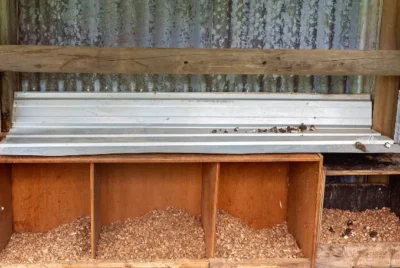How to Protect Your Coop from Digging Predators with Coop Apron
The safety and security of your chickens are paramount for any poultry enthusiast. Predatory animals can pose a significant threat, and some of them are expert diggers, making it essential to fortify your coop against these ground-based intruders. One effective and practical solution to safeguard your feathered friends is using coop aprons.
In this article, we’ll explore the importance of coop aprons and guide you through installing them to ensure your chicken coop remains a haven.

What Is a Coop Apron?
A coop apron or predator apron is a protective barrier typically made of sturdy materials such as hardware cloth or wire mesh that is placed around the perimeter of a chicken coop or run. It extends outward from the coop’s base, forming a skirt-like structure that lies flat on the ground.
The primary purpose of a coop apron is to prevent digging intruders, such as chicken predators, from burrowing their way into the coop. By creating this underground barrier, coop aprons effectively deter these potential threats and help ensure the safety and security of the chickens housed inside the coop.
They are essential to a comprehensive strategy for protecting chickens from ground-based predators.
Read also: How to Attach Hardware Cloth to Chicken Coop for Ultimate Protection

Types of Chicken Predators That May Dig into the Chicken Coop
- Raccoons: Raccoons are clever animals that can use their paws to dig and manipulate objects. They may attempt to dig under coop walls or fences to reach chickens.
- Skunks: Skunks are nocturnal creatures that often dig for food. They can burrow beneath the coop, seeking eggs and vulnerable chickens.
- Opossums: Opossums are opportunistic feeders who may dig around coop edges for eggs or chicks.
- Weasels: Weasels are small and agile, making them capable of digging small tunnels to access the coop and prey on chickens.
- Rats and Mice: Rodents are notorious for tunneling and can dig into coops through small openings or weak spots, continuously threatening eggs and chicks.
- Groundhogs (Woodchucks): These burrowing rodents are known for digging extensive tunnels, which can lead them to the coop’s foundation.
- Snakes: Some snake species, like rat snakes, may enter the coop through openings in search of eggs or young chicks.
- Badgers: In certain regions, badgers are a concern as they are skilled diggers and can create tunnels beneath the coop.
- Foxes: Foxes are skilled diggers and pose a significant threat to chickens. They can excavate tunnels or holes to access the coop and its inhabitants.
Read also: How To Fox-Proof and Raccoon-Resistant Your Chicken Coop
Benefits of Using Coop Aprons for Predator Proofing Your Coop

Effective Predator Deterrence
Coop aprons create a formidable barrier against digging predators, such as foxes, raccoons, and weasels. These barriers make it difficult for these animals to access the coop from beneath the ground, reducing the risk of attacks and losses.
Enhanced Security
Predator aprons add an extra security layer, particularly at night when many predators are most active. This added protection can greatly reduce the chances of predator incursions.
Reduced Losses
By preventing predators from reaching your chickens, coop aprons help minimize losses, including stealing eggs, chicks, or adult birds. This can save you both time and money.
Prolonged Coop Lifespan
Coop aprons help preserve the structural integrity of the coop by preventing animals from undermining the foundation. This reduces the risk of damage to the coop itself, potentially saving you repair or replacement costs.
Improved Chicken Health and Well-being
With increased protection, your chickens are less stressed and have a better chance of thriving, leading to healthier and more productive birds.
Cost-Effective Solution
Predator aprons are a cost-effective predator-proofing method compared to alternatives like electric fencing or reinforced coop construction. They offer long-term protection without significant ongoing expenses.
Minimal Maintenance
Predator aprons require minimal maintenance. Periodic inspections and repairs are usually needed to keep them effective.
Customization
Predator aprons can be tailored to fit the specific dimensions of your coop, making them suitable for a wide range of coop designs and sizes.
Humane and Sustainable
Predator aprons provide a humane way to protect your chickens from predators without resorting to lethal methods, promoting ethical and sustainable poultry-keeping practices.
How to Use Chicken Coop Aprons
Using predator aprons effectively involves several steps to ensure they provide the intended protection against digging predators. Here’s how to use chicken coop aprons:
Step 1: Measure Your Coop Dimensions
Before you begin, measure the dimensions of your chicken coop or run to determine the length and width required for your coop aprons. Ensure that you have exact measurements to avoid shortages or excess materials.
Step 2: Choose Appropriate Materials
Select suitable materials for your predator aprons. Common choices include hardware cloth, wire mesh, or other predator-resistant materials. Ensure that the material is durable and capable of withstanding digging attempts by predators.
Step 3: Prepare the Ground
Clear the area around the coop or run off any debris, rocks, or vegetation. Level the ground as much as possible to create a smooth surface.
Step 4: Cut and Shape Coop Aprons
Cut the chosen material into strips or sections according to your coop dimensions. Coop aprons should extend at least 12-18 inches (30-45 cm) outward from the base of the coop walls. You can create multiple strips and overlap them for added protection.
Step 5: Install Coop Aprons
Lay the coop aprons on the ground around the perimeter of the coop, with the extended portion facing outward. Ensure they lie flat on the floor and cover where digging predators might attempt to access the coop.
Step 6: Secure Coop Aprons
Use landscaping staples, U-shaped pins, or other appropriate fasteners to secure the coop aprons. Space the fasteners evenly along the apron’s edges to prevent any gaps or openings that predators could exploit.
Step 7: Overlap Sections (If Necessary)
If you use multiple coop aprons sections, overlap them by several inches to ensure continuous protection. Secure the overlapping areas together to create a seamless barrier.
Step 8: Inspect and Maintain
Regularly inspect the coop aprons for damage, wear, or shifting. Repair any holes or gaps promptly to maintain their effectiveness. Coop aprons should be checked as part of your routine coop maintenance.
Step 9: Complement with Other Security Measures
While coop aprons provide excellent protection against digging predators, consider using additional security measures, such as predator-proof fencing, motion-activated lights, or guard animals, to enhance your coop’s security further.
Step 10: Monitor Effectiveness
Continuously monitor your coop’s security to ensure that coop aprons and other measures effectively deter predators. Adjust and improve your security strategy as needed based on observed results.

Attach Your Chicken Coop Aprons Now
By following these steps and using coop aprons as part of your predator-proofing strategy, you can create a robust and effective barrier against digging predators, helping to keep your chickens safe and secure. With coop aprons in place, you can enjoy peace of mind, knowing that your chickens are protected from ground-based threats, and you can focus on enjoying the benefits of raising chickens without the constant worry of predatory intrusions.





